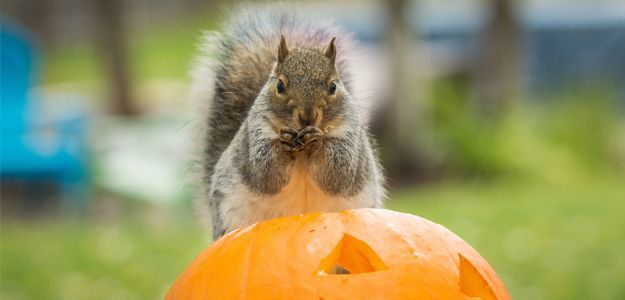Squirrel Management Services
Request a Quote
Hero Request Form
Types of Squirrels
Sciurus Carolinensis (Eastern Gray Squirrel)
Gray squirrels are polygamous breeders. They breed during December and January, as well as May and June. Gestation lasts 44 days, and young are born between February and March and July and August. Litters consist of two to three young. Gray squirrels typically produce one to two liters per year. The young will open their eyes at 35 days and venture out on their own at ten weeks. They are sexually mature at eight to nine months.
Gray squirrels will utilize leaf nests in trees and find or create access to a home. Common points of entry are found in soffits, walls or siding, and attic spaces. Chewing may be heard, and squirrels can cause wire damage and wood trim damage. Gray squirrels will eat just about any fruit or seed- or nut-bearing tree. It is common to see squirrels everywhere, from in the yard and up to the top of your home or nearby trees. When they nest in your attic or chimney, then you need squirrel removal services near you.
Sciurus Vulgaris (Eastern Red Squirrels)
This type of squirrel is a very aggressive chewer and may enter a home from underground all the way to the top. Red squirrels are active year-round. They love black walnuts and may even cache them in your attic or soffits! American red squirrels have their babies in their nests in late spring or early summer. They usually have three to six babies at a time, but they can have up to eight in one litter. They also will nurse their babies for about two months and then may have a second litter before winter.
Glaucomys Volans (Southern Flying Squirrel)
The least observed and most common squirrel found in Ohio is the southern flying squirrel. They are nocturnal and have a membrane between the legs to outstretch and utilize this extra surface area to help glide or “fly” from branch to branch. Breeding takes place twice a year, in April and May and between August and September. After a gestation period of about 38-42 days, two to six young are born. Flying squirrels are omnivorous and are found in deciduous forests or corridors. When found in an attic, they tend to sleep in colonies or whole family units.

Eastern Gray Squirrel. A very common culprit that enters attics.
Dealing With a Sick or Injured Squirrel
If you think there is a sick or injured squirrel on your property, you can contact a local wildlife rehabilitation center or individual.
Squirrel Management FAQ
Have a squirrel-related question? We have the answer. Check out these FAQs and give us a call today for more information!
How Can TLC Wildlife Management Help?
TLC Wildlife Management exclusively utilizes humane techniques for the eviction of squirrels and other wildlife. We use the behavior and biology of the squirrel to allow the animal to evict without harm. Points of access commonly found are at shingle and soffit junctures, at soffits near downspouts, open un-capped chimneys, attic vents, roof vents, and ridge vents. They are also commonly found under decks, sheds, and porches.
Our humane solution starts with a one-way door placed at the point of entry, ensuring only the target animals are addressed. The squirrels can leave on their own to feed, but cannot get back in. We then reunite any accessible offspring on the outside of the structure. The mother can collect her litter and move them safely to another location. TLC Wildlife Management then provides preventative solutions to prevent re-entry. This method results in less interaction with wildlife and fewer visits to your home.
We offer customized solutions that work for your home and lifestyle and all exclusion work is guaranteed. Request a quote or call us today to schedule an evaluation which includes interior, exterior, roof, and attic inspection. We will also provide detailed photos and education about your specific situation, resulting in a solution to help you coexist in harmony with your wild neighbors!







Share On: